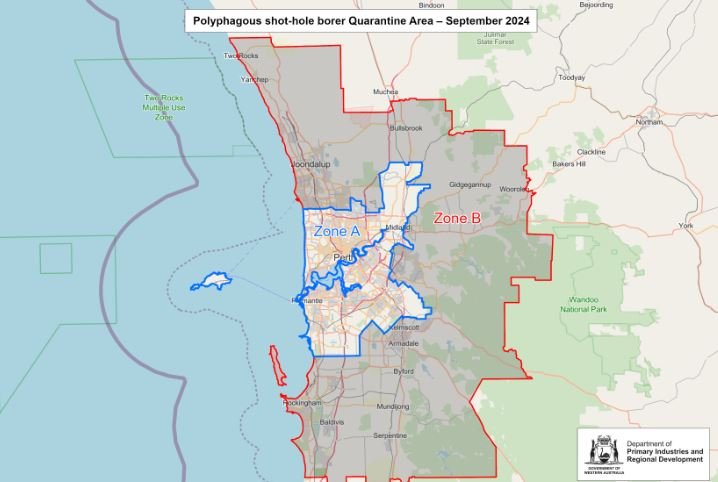PSHB Update 6 September 2024
Polyphagous shot-hole borer response - Industry update – 5 September 2024
Situation update
The Department of Primary Industries and Regional Development (DPIRD) is continuing efforts to eradicate polyphagous shot-hole borer (PSHB) from Western Australia (WA). Since response activities began in 2021, DPIRD officers have inspected more than 1.9 million trees on over 62,000 properties across the Perth metropolitan area. Surveillance for the pest also continues in regional areas, with no detections of the exotic beetle found outside of Perth. To assist eradication efforts and reduce the risk of PSHB moving into regional or growing regions, the current Quarantine Area (QA) is being expanded to cover the entire Perth Metropolitan Area. The expanded QA now covers 30 metropolitan local government areas with the new boundaries moving out to Armadale, Kwinana, Mundaring, Rockingham, and Serpentine Jarrahdale. Changes to the Quarantine Area
Through the gazettal of a Quarantine Area Notice (QAN) on Friday, 6 September 2024, the QA will expand to cover the entire Perth metropolitan area. To help control the spread of PSHB, the QAN restricts the movement of wood, plant materials, and green waste within the QA, and amendments to the QAN create two zones within the QA for a more efficient use of resources.Zone A covers an area with high numbers of infested trees, where intensive control activities such as tree removal are underway. This zone will have more restrictions on the movement of high-risk materials. Zone B covers an area with fewer or no infested trees and where heightened surveillance is underway to identify and control new infestations. This zone will help create a buffer between areas of high infestations and the rest of WA, further protecting WA’s growing regions.
Zone A Quarantine Area Requirements
Untreated or unseasoned wood or plant materials, including living plants, can only be moved within Zone A and cannot be moved out of Zone A or the QA.
Untreated or unseasoned wood and green waste cannot be moved outside Zone A unless they are chipped into pieces 2.5 cm or less in diameter.
Any machinery used to process green waste must be cleaned before it can be moved outside of Zone A.
Green waste can be moved from within Zone A to outside the QA or in Zone B if transported to a waste management premises on the list of PSHB waste management facilities.
Zone B Quarantine Area Requirements
Untreated or unseasoned wood or plant materials, including living plants, can be moved within Zone B or into Zone A but cannot be moved outside the QA.
Untreated or unseasoned wood and green waste cannot be moved outside of the QA unless they are chipped into pieces 2.5 cm or less in diameter.
Any machinery that processes green waste must be cleaned before moving outside the QA.
Green waste can be moved from within Zone B to outside the QA if transported to a waste management premises on the list of PSHB waste management facilities.
The above restrictions do not apply to grass and lawn clippings as these do not host the beetle. Anyone that cannot meet any of the above requirements must contact DPIRD for a permit before moving restricted materials.
Information on the QA, including an interactive map, can be found on the PSHB webpage - button below.
What to look for and how to report signs of PSHB
Warmer weather usually increases borer activity. DPIRD is encouraging all Western Australians to check their trees for signs of the borer, particularly those that host trees at the highest risk, such as box elder maples, coral trees, Moreton Bay and Port Jackson figs, and London plane trees.
Signs of borer activity include tiny holes the size of a ballpoint pen in the tree trunk or branches, staining or discoloration of the wood, gumming, frass, and signs of dieback in the tree.
Report all sightings to the department’s Pest and Disease Information Service on (08) 9368 3080 or email padis@dpird.wa.gov.au. Alternatively, they can send photos via the department’s MyPestGuide® Reporter app (Google Play Store and Apple iTunes Store).
Please visit the PSHB webpage for more information

